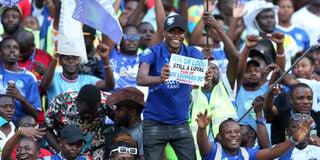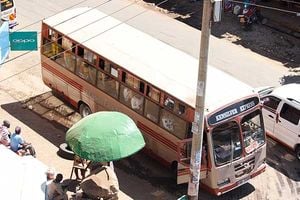Famous Mashemeji derby has lost its mojo

AFC Leopards fans cheer their team during their Football Kenya Federation Premier League match against Gor Mahia at Moi International Sports Centre, Kasarani on October 7, 2023.
What you need to know:
- Gor Mahia and AFC Leopards are the two most prominent football clubs in Kenya
- They have a long history of rivalry, but they both seem to have reached their peak years ago
- First of all, getting into the stadium was a big hassle that only those who arrived more than two hours earlier may have avoided
Another Mashemeji derby has come and gone, but where is the frenzy that once surrounded this storied contest? Where are the fans who filled the stadium until it burst and overflowed outside in rivers of green, white and blue? How did we go from selling out tickets a day before the game to begging fans to purchase them for half the price after kickoff? Who killed the social media battles that this fixture once ignited? Where are the travelling fans who once flocked Nairobi on such weekends from as far as Kakamega and Bungoma, Kisumu and Homabay, and even Kampala, Kigali ad Dar es Salaam?
I have watched more than a dozen Nairobi derbies in my one decade of following Kenyan football, but as enjoyable as these matches still are, it is the hollow feeling the morning after that has a greater impact on me now. And often, all I am left with is the question – will the passionate fans of Ingwe and K’Ogalo ever again rouse Kenyan football from its slumber?
Gor Mahia and AFC Leopards are the two most prominent football clubs in Kenya. They have a long history of rivalry, but they both seem to have reached their peak years ago. Today, their rivalry has faded, anyone who attended the Saturday match knows why.
First of all, getting into the stadium was a big hassle that only those who arrived more than two hours earlier may have avoided. Many of those who came driving entered the stadium after kickoff because the traffic started kilometres away, at the Roysambu exit. Getting secure parking space wasn’t easy either.
You didn’t escape the hassle if you came on foot, because the queue at the various gates was long and winding by the time the referee blew the opening whistle. You also risked losing your valuables because the push and shove at the pedestrian entry points was legendary. Needless to say, teargas was aplenty outside as everyone got impatient and tried to access the stadiums by any means.
On the pitch, it was a relief to see that the players have retained the same fast-paced urgency, although those who remember the days of Dan Sserunkuma and Meddie Kagere will disagree and say there is something missing in the current generation of players.
There are several reasons why this fixture has faded. The obvious one is poor planning and lack of investment. Many who once swore never to miss such a match long got tired of the ever present long queues, traffic jams and teargas, and waited on the live link or found better things to fill their weekends.
Inadequate investment in youth development programs and training facilities has also resulted in declining quality in the local league and squads of both teams. None of those clubs have any football academy and they don’t have any stadium to call home. Tok Komwanda (City Stadium) proved as close as we will ever come to seeing Gor Mahia play at home. Now K’Ogalo and Ingwe share Kasarani and Nyayo and both call these stadiums home, and the consequences are here for all to see.
A lot of the challenges in access and security may speak to the way Kasarani Stadium was designed and Kenyans’ penchant for the last minute rush, but leaders of the two clubs can certainly do better in terms of planning.





